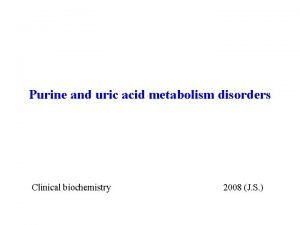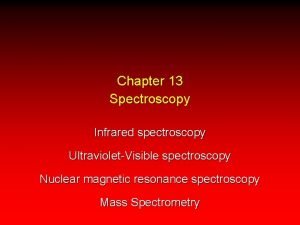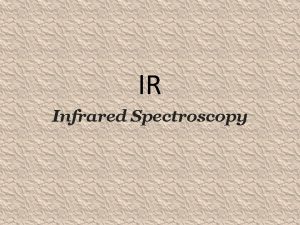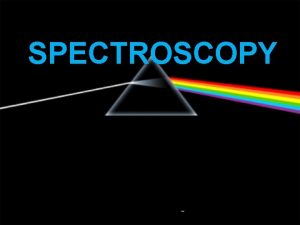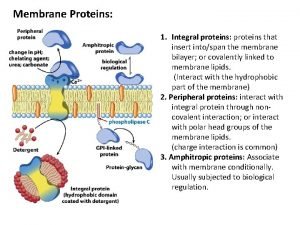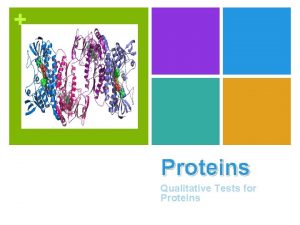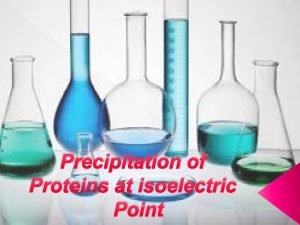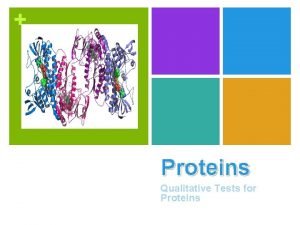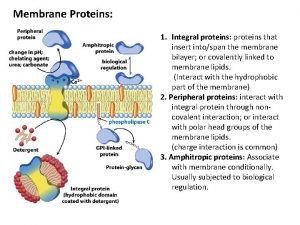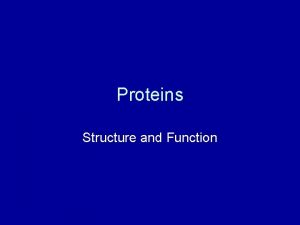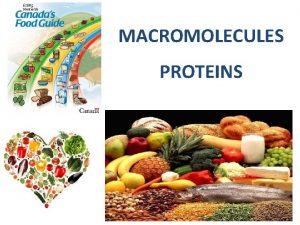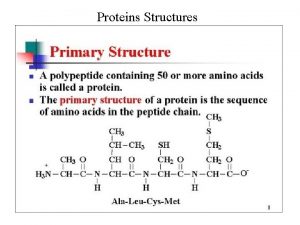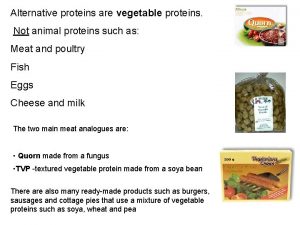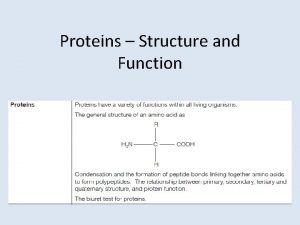Spectroscopy of Proteins Proteins The final product of


























- Slides: 26

Spectroscopy of Proteins

Proteins • The final product of the genes, translated form genes (mutation in gene leads to a mutated protein) • Made of a verity of 20 amino acid building blocks • Exert all the biological functions of the organism: enzymes, antibodies, cytoskeletons, hormones, receptors

Protein characteristics • Unbranched polymer • Folds into an accurate three dimensional structure (globular structure) • Correct folding is essential for the protein to exert its functions- tight structure-function relationship

Levels of protein structure

amino acid and peptide bond

The α-helix and β-sheet

? Protein spectroscopy- what for • Structural analysis- Shape, size and formsecondary and tertiary conforamtions • quantification • Interaction with other molecules (proteins, ligands and solutes).

Spectroscopic methods • • • Absorbance- UV-vis, FTIR Circular Dichroism (CD) Fluorescence- internal, labeling, polarization Light scattering- DLS, SAXS NMR X-ray diffraction (crystallography) Resolution of Structural analysis methods • Low: UV-vis absorbance, DLS, fluorescence • Medium: FTIR, CD, SAXS • High: X-ray diffraction, NMR

Molecular energy and light spectrum • Emolecule = Eelectronic + Evibrational + Erotational + Espin + Etranslational

Absorbance (and transmittance) Beer-Lambert’s law Chromophors in proteins • Peptidic bond (UV-CD and FTIR) • Aromatic amino acids (260 -300 nm) • Attached probe (varies, mostly vis)

Absorbance of aromatic amino acids

FTIR Energy levels associated with IR absorbance Molecular vibrations

Derivation and deconvolution

ATR (attenuated total reflectance)FTIR

CD Ellipticity: = L(l)- R (l) Ellipticity in degrees: Molar Ellipticity: Optical activity in proteins • Asymetric atoms ( C of amino acids) • Secondary structures ( helices and sheets) • Asymetric environment (of aromatic amino acids)

Secondary structure analysis Thermal stability analysis binding analysis

Fluorescence Fluorimetric setup 1. Excitation 2. Vibrational losses 3. Emission

Probes used in biology

GFP –Green Fluorescence Protein

Tryptophan fluorescence Trp blue shift

Fluorescence Resonance Energy Transfer (FRET) Energy at excited state of the donor is transmitted to an acceptor

Fluorescence Polarization (anisotropy) Very large molecules Very small molecules unpolarized Lifetime

Kinetic mechanism of binding

Fluorescence Microscopy

Light scattering Small angle X-ray scattering Solution versus crystal Dynamic light scattering

X-ray crystallography and NMR
 The final product of glycolysis is
The final product of glycolysis is Prdp biochemistry
Prdp biochemistry Final product of translation
Final product of translation Sơ đồ cơ thể người
Sơ đồ cơ thể người Công của trọng lực
Công của trọng lực Bảng số nguyên tố
Bảng số nguyên tố đặc điểm cơ thể của người tối cổ
đặc điểm cơ thể của người tối cổ Tỉ lệ cơ thể trẻ em
Tỉ lệ cơ thể trẻ em Các châu lục và đại dương trên thế giới
Các châu lục và đại dương trên thế giới ưu thế lai là gì
ưu thế lai là gì Tư thế ngồi viết
Tư thế ngồi viết Thẻ vin
Thẻ vin Các môn thể thao bắt đầu bằng tiếng bóng
Các môn thể thao bắt đầu bằng tiếng bóng Cái miệng nó xinh thế
Cái miệng nó xinh thế Hát kết hợp bộ gõ cơ thể
Hát kết hợp bộ gõ cơ thể Mật thư tọa độ 5x5
Mật thư tọa độ 5x5 Từ ngữ thể hiện lòng nhân hậu
Từ ngữ thể hiện lòng nhân hậu Trời xanh đây là của chúng ta thể thơ
Trời xanh đây là của chúng ta thể thơ Tư thế ngồi viết
Tư thế ngồi viết V. c c
V. c c Gấu đi như thế nào
Gấu đi như thế nào Thể thơ truyền thống
Thể thơ truyền thống Hươu thường đẻ mỗi lứa mấy con
Hươu thường đẻ mỗi lứa mấy con Thế nào là hệ số cao nhất
Thế nào là hệ số cao nhất Diễn thế sinh thái là
Diễn thế sinh thái là Lp html
Lp html Vẽ hình chiếu vuông góc của vật thể sau
Vẽ hình chiếu vuông góc của vật thể sau

